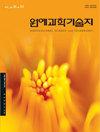辣椒连作田优势微生物群落及多样性鉴定
IF 0.8
4区 农林科学
Q3 HORTICULTURE
Korean Journal of Horticultural Science & Technology
Pub Date : 2021-08-01
DOI:10.7235/HORT.20210039
引用次数: 0
摘要
辣椒疫病是影响辣椒连作最主要的土传病害。为了确定辣椒疫霉感染对微生物区系的影响,我们从辽宁省连续种植辣椒3年、6年和9年的辣椒病农场根际土壤中分离并统计了微生物。记录了细菌和放线菌的菌落和细胞形态、生理生化特征以及16S rDNA序列。此外,还分析了真菌的菌落和显微形态以及rDNA-ITS序列进行分类。结果表明,健康和患病辣椒根际细菌数量最多,其次是放线菌和真菌。感染后,细菌和放线菌数量减少,真菌数量相应增加,导致细菌/真菌与放线菌/真菌之比降低。鉴定出15株优势菌株,其中芽孢杆菌属数量最多,有7株,其次是黄杆菌和葡萄球菌。17株放线菌中有15株属于链霉菌属。在6株真菌中,我们发现了P. infestans、Fusarium和Penicillium各2株。本研究阐明了致病性辣椒杆菌随时间变化对土壤微生物组成的影响,并鉴定了几种可培养的优势菌群,为改善连作土壤条件的实际干预策略提供依据。附加关键词:连作,优势微生物,微生物群落,辣椒,辣椒疫霉本文章由计算机程序翻译,如有差异,请以英文原文为准。
Identification of Dominant Microbial Community and Diversity in Continuously Cropped Pepper Fields
Pepper blight is the most significant soil-borne disease affecting the continuous cropping of peppers. To identify the effect of Phytophthora capsici infection on microbial flora, we isolated and counted the microorganisms collected from the rhizosphere soil of P. capsici-affected farms that continuously cropped pepper for 3, 6, and 9 years in Liaoning Province, China. The colony and cell morphology, physiological and biochemical characteristics, and 16S rDNA sequence of bacteria and actinomycetes were documented. In addition, colony and microscopic morphology of fungi and the rDNA-ITS sequence were analysed for classification. We observed that healthy and diseased peppers had the largest number of bacteria in the rhizosphere followed by actinomycetes and fungi. After infection, the number of bacteria and actinomycetes decreased with a corresponding increase in the number of fungi, leading to a reduction in the ratio of bacteria/fungi to actinomycetes/fungi. We identified 15 dominant bacterial strains, of which Bacillus represented the most abundant genus consisting of 7 strains followed by Flavobacterium and Staphylococcus. Furthermore, 15 of the 17 actinomycetes strains belonged to the genus Streptomyces. Among the six fungal strains, we found P. infestans, Fusarium, and Penicillium consisting of two strains each. This study elucidated the impact of pathogenic P. capsici on the composition of soil microbes over time and characterized several cultivatable dominant bacterial groups, which can provide a basis for practical intervention strategies to improve soil conditions for continuous cropping. Additional key words: continuous cropping, dominant microorganism, microbial community, pepper, Phytophthora capsica
求助全文
通过发布文献求助,成功后即可免费获取论文全文。
去求助
来源期刊
CiteScore
2.00
自引率
0.00%
发文量
0
审稿时长
1 months
期刊介绍:
Horticultural Science and Technology (abbr. Hortic. Sci. Technol., herein ‘HST’; ISSN, 1226-8763), one of the two official journals of the Korean Society for Horticultural Science (KSHS), was launched in 1998 to provides scientific and professional publication on technology and sciences of horticultural area. As an international journal, HST is published in English and Korean, bimonthly on the last day of even number months, and indexed in ‘SCIE’, ‘SCOPUS’ and ‘CABI’. The HST is devoted for the publication of technical and academic papers and review articles on such arears as cultivation physiology, protected horticulture, postharvest technology, genetics and breeding, tissue culture and biotechnology, and other related to vegetables, fruit, ornamental, and herbal plants.

 求助内容:
求助内容: 应助结果提醒方式:
应助结果提醒方式:


